Scottish Schools Adolescent Lifestyle and Substance Use Survey (SALSUS) Data Over Time - Stage 1: Feasibility Report
This report summarises changes in the methodology and questionnaire coverage of SALSUS over time that could impact on the feasibility of producing a unified data-set. It concludes that the data is consistent enough that a combined dataset would allow meaningful analysis of trends over time and posit that Stage 2 of the research should proceed. It also set out recommendations.
3. Conclusions and Recommendations
3.1.The survey's objective has been consistent over the years. It has used the same method of data collection (paper self-completion among children in school), and similar sampling strategies (all designed to provide nationally representative estimates at a minimum). While the scope of the survey has increased over time, there has been a large degree of consistency across waves.
3.2.Therefore, we conclude that the data is consistent enough between years for a combined dataset to allow meaningful analysis of trends over time. Stage 2 of the research should proceed.
3.3.With regard to the change in sample design between 2000 and 2002:
- The data for 2000 and before should not be amended to bring it into line with 2002 (by stripping out the data for S1 and S3 pupils) as secondary analysts may want to compare the full S1 to S4 data between 1990 and 2000.
- Instead, this change in sample coverage should be prominent in the user guide.
- Additionally, variables combining the weights from different waves should be designed to make it easy to carry out appropriate analysis of trends over time and difficult to carry out incorrect analysis. (This would be done by setting the values in the main weighting variables to 0 for S1 and S3 pupils in the earlier waves, but including this weighting data in supplementary variables).
3.4.With regard to the later fieldwork period in the 2002 and 2004 waves (and therefore the older average age of respondents):
- The data for 2002 and 2004 cannot be amended to control for this difference. The user guide should, however, clearly highlight this. It should include a section on average age of pupils in each year group by wave if possible - to help ensure that secondary analysts are made aware of the difference.
3.5.With regard to coverage of the combined dataset:
- Questions that have been asked in at least three separate waves should be included in the combined dataset.
- Questions that have been asked in the 2010 and 2013 waves (and will be included in the 2015 wave).
- Some questions comprise a sizeable number of individual components to derive the main measures. For these, the combined data-set should only include the main measures and key sub-measures. (For example: a) total number of units of alcohol consumed in the last week and number of units for each type of alcohol - but not alcohol by type by how consumed; b) number of brands of cigarettes mentioned, but not whether mentioned each brand separately; c) Main Strengths and Difficulties Score and scores for each internal scale (but not scores for each individual question).
- Where there has been a change in a question wording, response categories or routing that is likely to affect comparability over time, we would include the data in separate variables (with related names). We will discuss these with the Scottish Government as Stage 2 progresses and fully document these in the user documentation.
3.6.We would also recommend:
- If any discrepancies are discovered between the published results and the deposited data, we would discuss the appropriate course of action with the Scottish Government.
- That the variables in the combined data are named using conventions based on the topic area. (For example, all questions relating to smoking starting S_....)
Figure 4: Summary of coverage over time of smoking related questions
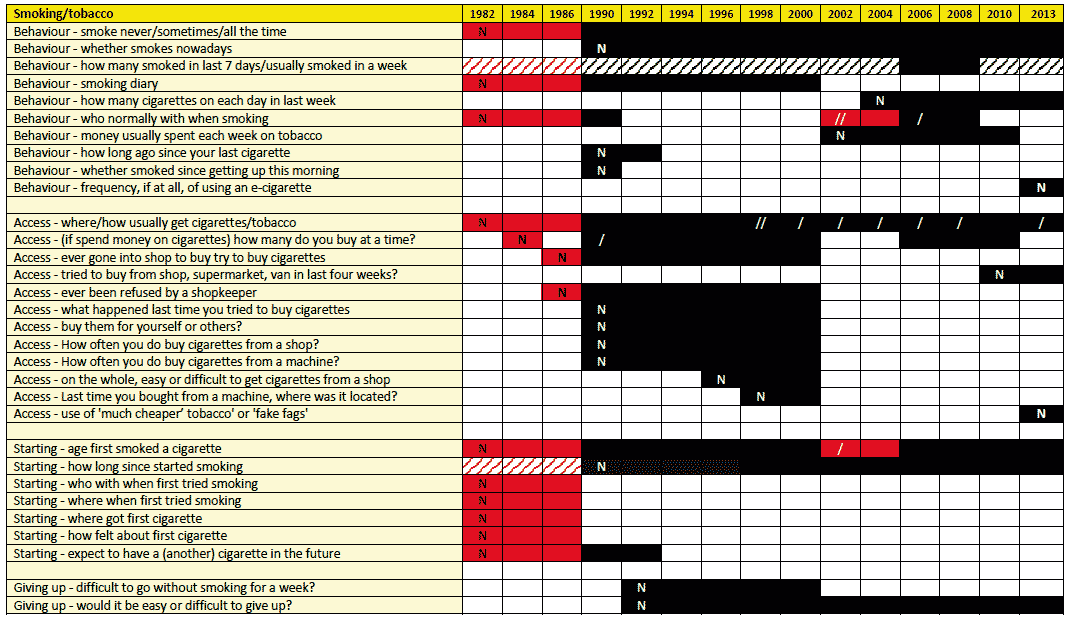
Figure 5: Summary of coverage over time of alcohol related questions
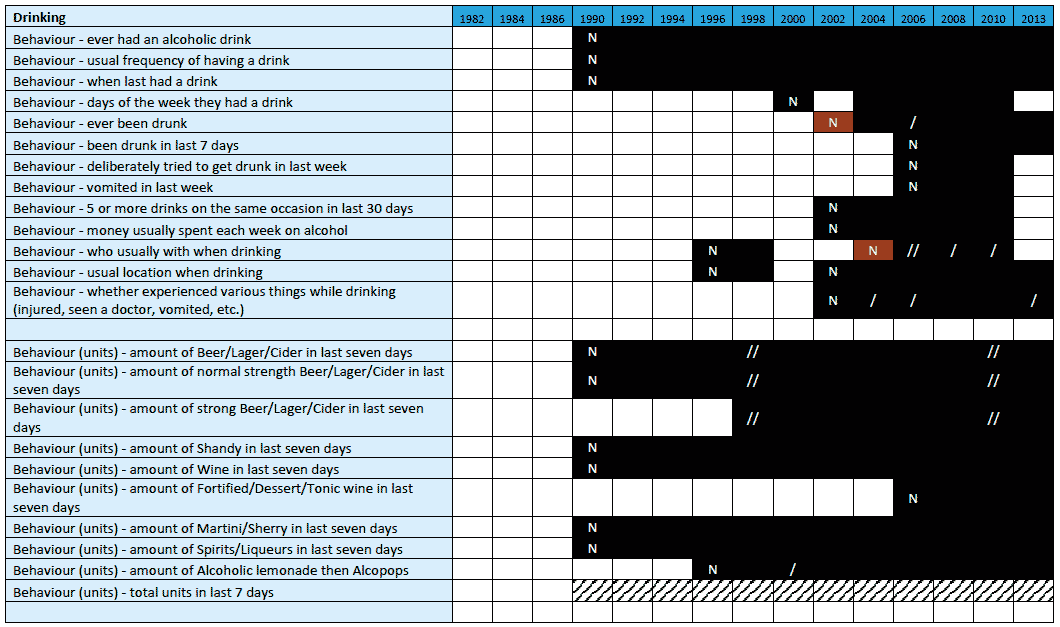
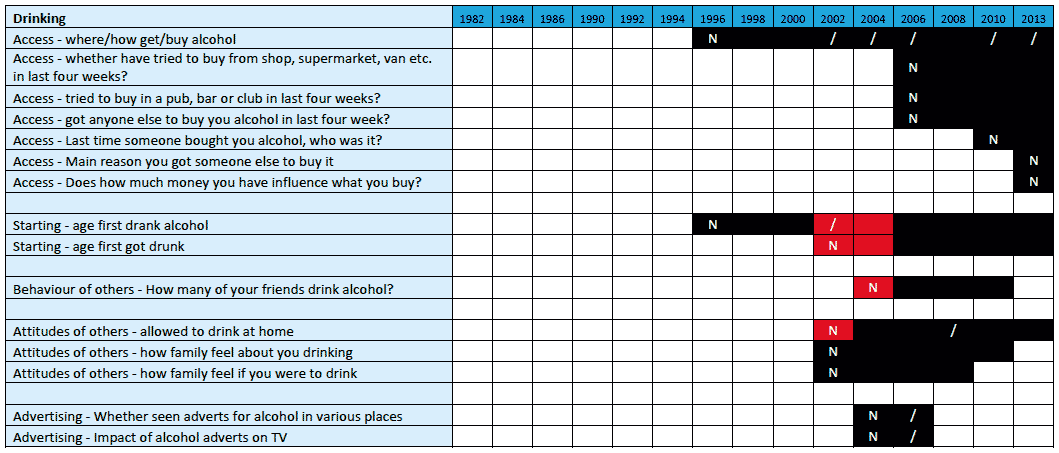
Figure 6: Summary of coverage over time of drugs related questions
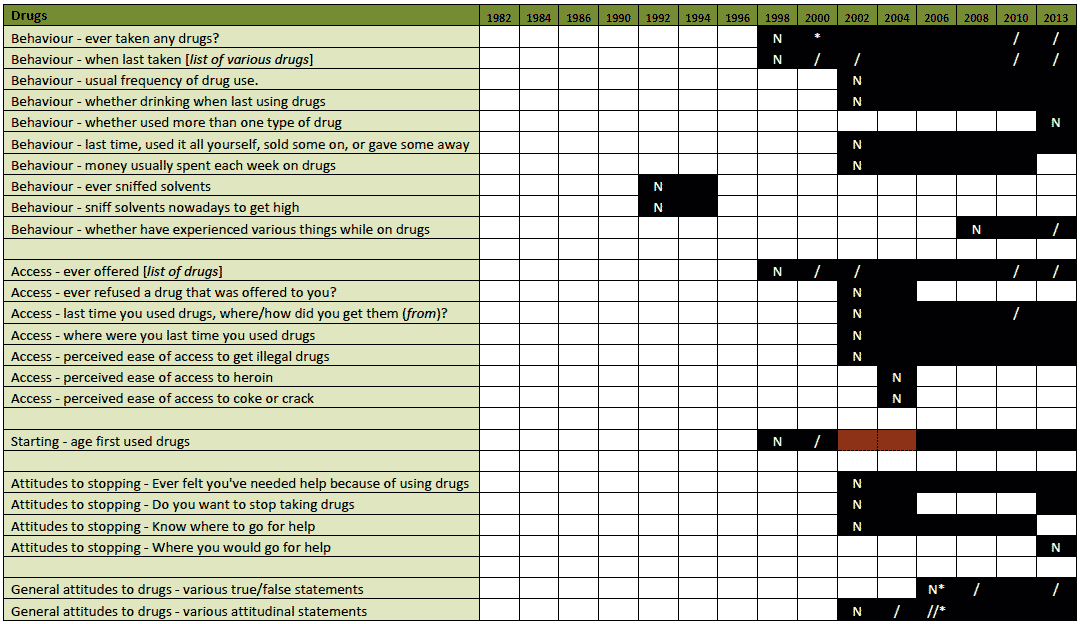

Figure 7: Summary of coverage over time of questions related to sport, leisure, social contact, mental well-being and school.
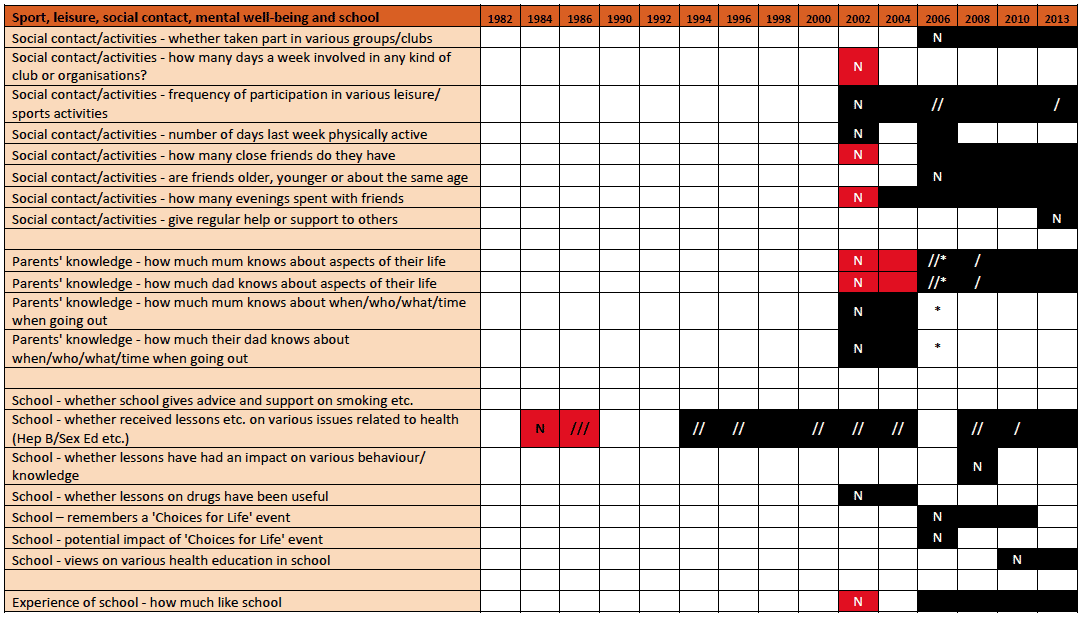
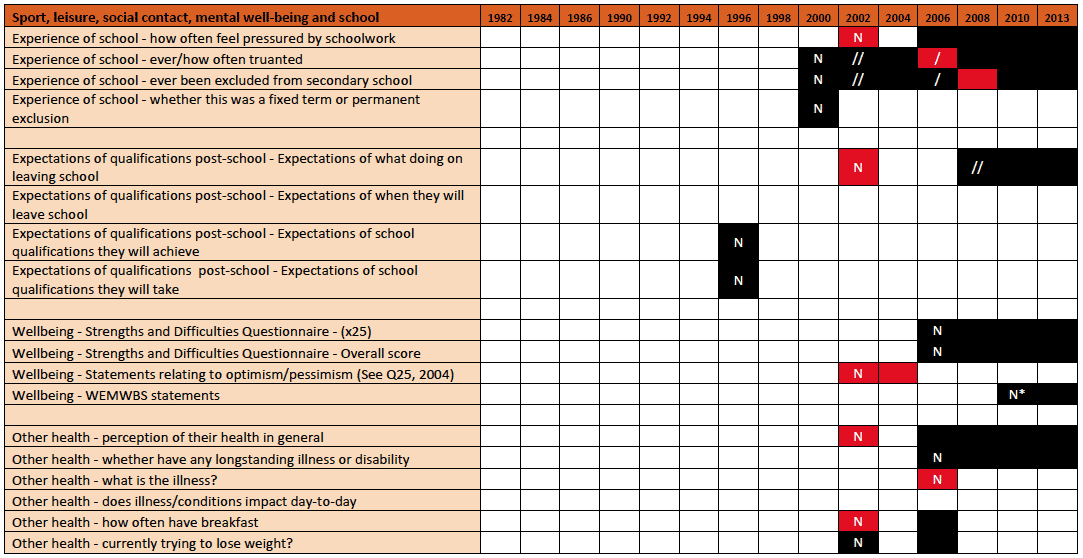
Figure 8: Summary of coverage of demographic information and other contextual information.
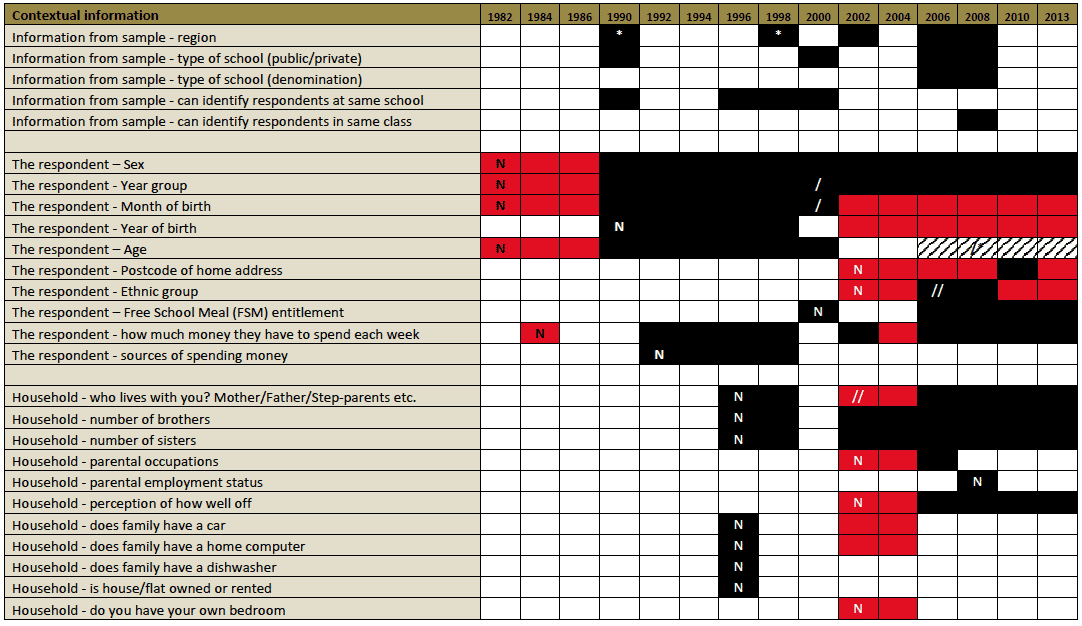

Figure 9a: Summary of methodology (1982 to 1998)
| Methodology | 1982 | 1984 | 1986 | 1990 | 1992 | 1994 | 1996 | 1998 |
|---|---|---|---|---|---|---|---|---|
| Data available from the Data Archive | No | No | No | Yes | Yes | Yes | Yes | Yes |
| Who carried it out | ODPM | ODPM | ODPM | OPCS | OPCS | ONS | ONS | ONS |
| Target population - age/year groups included | 1st to 4th form | S1 to S4 | S1 to S4 | S1 to S4 | S1 to S4 | S1 to S4 | S1 to S4 | S1 to S4 |
| Target population - State and Independent schools? | Y | Y | Y | Y | Y | Y | Y | Y |
| Summary of sampling approach | Random sample of schools and then a sample of pupils from schools | Random sample of schools and then a sample of pupils from schools | Random sample of schools and then a sample of pupils from schools | Random sample of schools and then a sample of pupils from schools | Random sample of schools and then a sample of pupils from schools | Random sample of schools and then a sample of pupils from schools | Random sample of schools and then a sample of pupils from schools | Random sample of schools and then a sample of pupils from schools |
| Designed to be representative at Alcohol Drug Action Team (ADAT) level | Y | Y | Y | Y | Y | Y | Y | Y |
| Designed to be representative at Local Authority level | N | N | N | N | N | N | N | N |
| Designed to be representative at NHS Board level | N | N | N | N | N | N | N | N |
| Designed to be representative at NHS Board level | N | N | N | N | N | N | N | N |
| Fieldwork dates | Oct/Nov 1982 | Oct/Nov 1984 | Unclear | Oct/Nov 1990 | Oct/Nov 1992 | Oct/Nov 1994 | Oct/Nov 1996 | Oct/Nov 1998 |
| Achieved sample in Scotland | 2,287 | 2,798 | 2,710 | 2,681 | 2,917 | 2,725 | 2,397 | 3,538 |
| Number of schools that took part in Scotland | 69 | 85 | 81 | ? | 96 | 92 | 82 | 122 |
| School response rate | 96% | 89% | 82% | 92% | 96% | 92% | 82% | 81% |
| Pupil response rate | 87% | 91% | 91% | 90% | 90% | 90% | 89% | 89% |
| Overall response rate | 84% | 80% | 78% | 87% | 86% | 83% | 73% | 70% |
| Note on weighting | None | Unclear | Unclear | Unclear | Unclear | Unclear | Unclear | School year (probability of selection of each year varied across schools) |
Figure 9b: Summary of methodology (2000 to 2013)
| Methodology | 2000 | 2002 | 2004 | 2006 | 2008 | 2010 | 2013 |
|---|---|---|---|---|---|---|---|
| Data available from the Data Archive | Yes | Yes | Yes | Yes | Yes | Yes | Yes |
| Who carried it out | NFER | HBSC | HBSC | BMRB | Ipsos MORI | Ipsos MORI | Ipsos MORI |
| Target population - age/year groups included | S1 to S4 | S2+S4 | S2+S4 | S2+S4 | S2+S4 | S2+S4 | S2+S4 |
| Target population - State and independent schools? | Y | Y | Y | Y | Y | Y | Y |
| Summary of sampling approach | Two stage - sample of schools and then sample of pupils | School-based stratified sample, with class as the PSU | School-based, stratified sample, with class as the PSU | School-based, stratified sample, with class as the PSU | School-based, stratified sample, with class as the PSU | School-based, stratified sample, with class as the PSU | School-based stratified cluster sample, with class as the PSU |
| Designed to be representative at Scotland level | Y | Y | Y | Y | Y | Y | Y |
| Designed to be representative at Alcohol Drug Action Team (ADAT) level | N | Y | N | Y | N - though enough to monitor prevalence | Y | Y |
| Designed to be representative at Local Authority level | N | Y | N | Y | N - though enough to monitor prevalence | Y | Y |
| Designed to be representative at NHS Board level | N | Y | N | Y | N - though enough to monitor prevalence | Y | Y |
| Fieldwork dates | Sept-Dec, 2000 | Spring Term, 2003 | Spring Term, 2005 | Autumn term 2006 | Sept 2008 - Feb 2009 | Sept 2010 - Feb 2011 | Sept 2013 - Mar 2014 |
| Achieved sample in Scotland | 4,774 | 23,090 | 7,062 | 23,180 | 10,063 | 37,307 | 33,685 |
| Number of schools that took part in Scotland | 150 | 314 | 194 | 258 | 253 | 302 | 283 |
| School response rate | 72% | 75% | 72% | 69% | 69% | 75% | 71% |
| Pupil response rate | 90% | 89% | 87% | 82% | 91% | 91% | 90% |
| Overall response rate | 64% | 65% | 62% | 57% | 59% | 62% | 60% |
| Note on weighting | No weighting | Unclear | No weighting | Sex, Year, School type (x2), area | Sex, Year, School type (x2), area | Sex, Year, School type (x2), area | Sex, Year, School type (x2), area |
How to access background or source data
The data collected for this social research publication
☒ are available via an alternative route of the UK Data Archive
Contact
Email: Emma McCallum
There is a problem
Thanks for your feedback